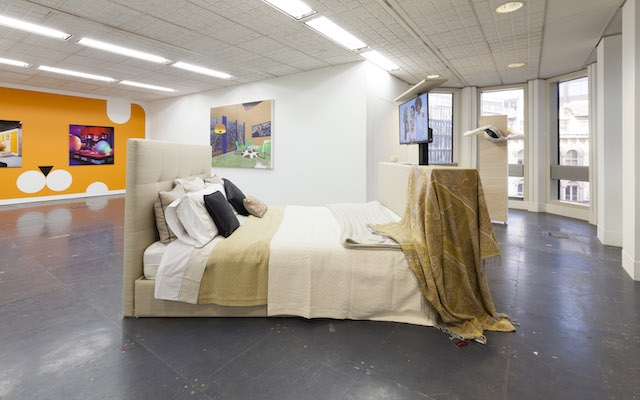‘The future’s not what it used to be,’ Robert Graves and Laura Riding quipped 80 years ago. Billed as an exhibition ‘on gender, domesticity and technology in the present’, this sparse show – comprising just nine works by six artists – offers a chance to consider futures past, as well as those still to come. Take Lynn Hershman Leeson’s Digital Venus #1: After Titian (1996): a slight work by a great artist, this colour print sees the exposed flesh of Titian’s Venus of Urbino (1538) – itself a radical innovation in its time, pioneering the presentation of the nude in a commonplace domestic setting, unsupported by mythological allusion – overlaid with circuit board. Made one year before the first Cyberfeminist International, the work’s thin, two-dimensional imagination of the merging of living subject and machine seems almost quaint: it reminded me a little of the cover of Add N to (X)’s 1998 album, On the Wires of our Nerves – in which a synth deck emerges from a woman’s bloody chest – minus the deadpan humour.
The work of onetime Pictures Generation artist Vikky Alexander offers another intriguing historical position, represented in the form of two mid-2000s digital-collages on canvas (2006’s Rising River and 2007’s Green Lake). Both depict domestic interiors, unreal in their cheerful sterility, with the floating, weightless quality of buildings designed in SketchUp (the looming presence of the titular bodies of water, stretching across each depicted room’s floor-to-ceiling windows, further unmoors the scenes’ stability). They are charming, quietly unsettling things, yet when compared to much of the flood of ‘post-Internet art’ that would follow a few years later, also strikingly traditional, feeling as close in spirit to Patrick Caulfield as, say, Cory Arcangel.
There are further Pop echoes, too, in two contemporary works, drawn from Ad Minoliti’s Queer Deco series. Displayed against a lozenge-shaped orange wall vinyl (Puppy, 2017), the kitsch fantasy space of Queer Deco (Visiona 1) and Queer Deco (Total Furnishing Unit) (both 2017) both reek of Richard Hamilton, but replacing the cartoonishly heteronormative inhabitants of Just what is it that makes today’s homes so different, so appealing? (1956) with genderless geometric presences.
Whatever else the dialogue between these works raised, one resounding impression is of how closely aligned gender and domestic space both have been and remain: how when we talk about the home, we are still in some sense talking about the feminine (however construed). It is striking, then, that the installation here by DIS, Sleep Mode (2017), while drawing its title from IT, takes the form of a videowork mimicking cable TV channel hopping – with snatches of family scenes, women jogging and formal public apologies – played from a fullscale double bed, in which the viewer can settle. Evoking a slightly hysterical version of a ‘duvet day’ at home, the work immerses the viewer in a gendered world of comfort and soft feelings. What DIS do is often treated as cultural prophecy; here, I’d say the prediction is: the future is, in some sense, female.
Ad Minoliti, Aleksandra Domanović, DIS, Lynn Hershman Leeson, Vikky Alexander, Wang Newone at Project Native Informant, London, 2 November – 9 December
From the January & February 2018 issue of ArtReview
